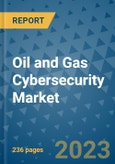The global oil & gas cybersecurity market is on a robust growth trajectory, with a projected CAGR of 5.8% from 2023 to 2030, according to a report. The market is expected to reach a staggering US$44.2 billion by 2030. This growth is driven by several key factors, including the critical need for data protection, increased digitalization, rising cyber threats, and evolving attack vectors.Global demand for oil & gas cybersecurity services and solutions poised to witness a CAGR of 5.8% during 2023 - 2030
Key Market Insights
1. Leaders in Cybersecurity Adoption Companies such as OMV, ExxonMobil, and Equinor are at the forefront of cybersecurity adoption within the oil & gas industry, recognizing the importance of safeguarding their operations against evolving threats.2. Prominent Cybersecurity Vendors Leading vendors providing cybersecurity solutions to the oil & gas industry include Siemens Energy, RigNet, Fortinet, Forescout, Mission Secure, Sectrio, Kognitiv Spark, XONA, Darktrace, and EY.
3. Upstream Sector Dominance The upstream oil and gas sector is expected to be the major consumer of cybersecurity solutions through 2030, as it requires robust protection due to its role in bringing crude oil to the surface.
4. Growing Demand for Services Services account for a higher demand share than hardware or software, reflecting the need for customized cybersecurity solutions tailored to the industry's unique requirements.
5. North America and Europe Leading North America and Europe collectively hold over 70% of the global oil & gas cybersecurity market, as the regions prioritize cybersecurity investments to secure their critical energy infrastructure.
Key Growth Drivers
1. Confidential Data Protection The increasing global energy industry's growth and the need to protect confidential data against cyber threats drive the demand for cybersecurity solutions in the oil & gas sector.2. Increased Digitalization The industry's digital transformation, including IoT adoption, remote monitoring, and data analytics, creates a greater attack surface, necessitating comprehensive cybersecurity solutions.
3. Rising Cyber Threats The oil and gas industry faces escalating cyber threats, including ransomware and nation-state-sponsored attacks, underscoring the need for advanced threat detection and response solutions.
4. Evolving Attack Vectors Cyber threats continually evolve, requiring innovative cybersecurity solutions, including AI and ML-based threat detection, to adapt to emerging risks.
Key Challenges
1. Legacy Systems Modernizing legacy infrastructure while maintaining operational continuity poses a challenge, as older systems were not originally designed with cybersecurity in mind.2. Resource Constraints Budget limitations and a shortage of qualified cybersecurity talent hinder the industry's ability to invest in and maintain robust cybersecurity measures.
3. High Initial Costs Small-to-mid-sized oil & gas firms are hesitant to invest in costly cybersecurity infrastructure, despite the growing need for protection.
Regulatory Landscape
Governments and industry bodies are imposing stringent cybersecurity regulations on the oil & gas sector to safeguard critical energy infrastructure. Compliance with standards like NIST and NERC CIP is not only legally required but also a competitive advantage. Non-compliance can result in legal and financial penalties.Key Trends and Opportunities
- Convergence of IT and OT Security Unified cybersecurity strategies that protect both IT and OT environments are gaining prominence.- Advanced Threat Detection and Response AI and ML-based cybersecurity solutions are on the rise for proactive threat identification.
- Supply Chain Security Focus on securing the entire vendor and partner ecosystem to mitigate risks.
- Cloud Security for Remote Operations The industry's embrace of cloud technologies requires secure cloud-based asset protection.
- Threat Intelligence Sharing Collaborative threat intelligence sharing among industry stakeholders is increasing.
- Workforce Training and Awareness Employee awareness and training programs are essential to reduce insider threats.
- Compliance-as-a-Service Managed compliance services help streamline regulatory obligations.
- Threat-Hunting Services Proactive threat hunting is crucial to identify and mitigate threats swiftly.
Regional Insights
- North America Leading investment in cybersecurity solutions due to a high number of cyberattacks across industries.- Europe Collaborative efforts to address cybersecurity concerns and protect against cyberattacks.
- Asia Pacific Growing need for cybersecurity systems with governments focusing on strengthening cybersecurity.
Competitive Landscape
The oil & gas cybersecurity market features a dynamic competitive landscape with established cybersecurity companies, niche players, and industry-specific providers. Consolidation is expected in the coming years as the industry continues to evolve.Key Players in Global Oil & Gas Cybersecurity
- CISCO- Symantec Corporation
- Honeywell Corporation
- Intel Corporation
- GE
- Microsoft Corporation
- Siemens AG
- Parson Corporation
- Rapid7
- ABB
- Schneider
This product will be delivered within 1-3 business days.
Table of Contents
1. Executive Summary
2. Market Overview
4. Global Oil & Gas Cybersecurity Market Outlook, 2019 - 2030
5. North America Oil & Gas Cybersecurity Market Outlook, 2019 - 2030
6. Europe Oil & Gas Cybersecurity Market Outlook, 2019 - 2030
7. Asia Pacific Oil & Gas Cybersecurity Market Outlook, 2019 - 2030
8. Middle East & Africa Oil & Gas Cybersecurity Market Outlook, 2019 - 2030
9. Latin America Oil & Gas Cybersecurity Market Outlook, 2019 - 2030
10. Competitive Landscape
11. Appendix
Companies Mentioned
- CISCO
- Symantec Corporation
- Honeywell Corporation
- Intel Corporation
- GE
- Microsoft Corporation
- Siemens AG
- Parson Corporation
- Rapid7
- ABB
- Schneider
Methodology

LOADING...








